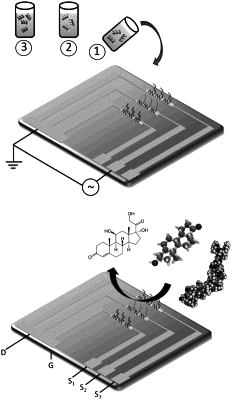| CPC C12Q 1/6825 (2013.01) [B82Y 35/00 (2013.01); B82Y 40/00 (2013.01); C12Q 2500/00 (2013.01); C12Q 2560/00 (2013.01); G01N 2333/005 (2013.01); G01N 2333/195 (2013.01); G01N 2333/37 (2013.01); G01N 2458/00 (2013.01)] | 29 Claims |

|
1. A method of assembling a biosensor device comprising two or more biosensor units, wherein each unit is capable of detecting a different target molecule in a sample, and wherein each unit comprises one or more biosensors each capable of detecting the same target molecule, the method comprising:
(i) performing a first cycle to assemble a first biosensor unit comprising:
A. providing a first solution comprising a population of first carbon nanotubes (CNTs) coated with nucleic acid molecules, wherein nucleic acid molecules are functionalised with functional groups suitable for coupling first sensor molecules to nucleic acid molecules, wherein each first sensor molecule is capable of binding to a first target molecule;
B. providing a substrate comprising a plurality of electrode pairs;
C. introducing the first solution to the substrate and immobilising one or more first coated CNTs across a junction separating a first electrode pair, wherein each first coated CNT forms an electrical connection between electrodes of the first electrode pair;
D. coupling one or more first sensor molecules to the nucleic acid of each first coated CNT, wherein each first sensor molecule is capable of binding to a first target molecule;
E. washing the entire substrate to remove non-immobilised first coated CNTs; and
(ii) performing a second cycle to assemble a second biosensor unit comprising repeating steps (A) to (E), wherein in repeat step (A) the first solution is replaced with a second solution, the population of first coated CNTs is replaced with a population of second coated CNTs, and wherein functional groups are suitable for coupling second sensor molecules to nucleic acid molecules; wherein in repeat step (C) the first solution is replaced with a second solution, the one or more first coated CNTs are replaced with one or more second coated CNTs, and the first electrode pair is replaced with a second electrode pair; and wherein in repeat step (D) the one or more first sensor molecules are replaced with one or more second sensor molecules, wherein each second sensor molecule is capable of binding to a second target molecule.
|